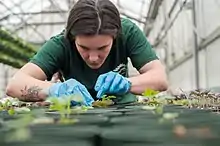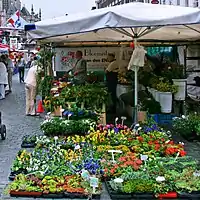Horticulture
Horticulture is the art and science of cultivating ornamental plants in gardens for ornamental purposes. Horticulturists are agriculturists who grow ornamental plants, trees and lawns.[1][2][3]


The study and practice of horticulture have been traced back thousands of years. Horticulture contributed to the transition from nomadic human communities to sedentary, or semi-sedentary, horticultural communities.[4] Horticulture is divided into several categories which focus on the cultivation and processing of different types of plants and food items for specific purposes. In order to conserve the science of horticulture, multiple organizations worldwide educate, encourage, and promote the advancement of horticulture. Some notable horticulturists include Luca Ghini and Luther Burbank.
Definition

Horticulture involves plant propagation and cultivation to improve plant growth, yields, quality, nutritional value, and resistance to insects, diseases, and environmental stresses. It also includes plant conservation, landscape restoration, soil management, landscape and garden design, construction and maintenance, and arboriculture. The word horticulture is modeled after agriculture; it derives from the Latin words hortus and cultura, which mean “garden” and “cultivation”, respectively.[5] In contrast to agriculture, horticulture does not include intensive crop farming and large-scale crop production or animal husbandry. Additionally, horticulture focuses on the use of small plots with a wide variety of mixed crops while agriculture focuses on one large primary crop at a time.
Types
There are several major areas of focus within the science of horticulture.[1] They include:
- Olericulture: the production of vegetables.
- Pomology, also called fruticulture: the production of fruits and nuts.
- Viticulture: the production of grapes (largely intended for winemaking).
- Floriculture: the production of flowering and ornamental plants.
- Turf management: the production and maintenance of turf grass for sports, leisure and amenity use.
- Arboriculture: the cultivation and care of individual trees, shrubs, vines, and other perennial woody plants, primarily for landscape and amenity purposes.
- Landscape horticulture: the selection, production and care of plants used in landscape architecture.
- Postharvest physiology: the management of harvested horticultural crops to retard spoilage while stored or transported.
History
The history of horticulture overlaps with the history of agriculture and history of botany.
The origins of horticulture lie in the transition of human communities from a nomadic lifestyle as hunter-gatherers to sedentary, or semi-sedentary, horticultural communities. In the Pre-Columbian Amazon Rainforest, natives used biochar to enhance soil productivity by smoldering plant waste.[6] European settlers called this soil Terra Preta de Indio.[7] In forest areas, such horticulture was often carried out in swiddens, or "slash and burn" areas.[8] In pre-contact North America, the semi-sedentary horticultural communities of the Eastern Woodlands, who grew maize, squash, and sunflower, contrasted markedly with the nomadic hunter-gatherer communities of the Plains people. Mesoamerican cultures focused in the cultivating of crops on a small scale, such as the “milpa” or maize field, around their dwellings or in specialized plots which were visited occasionally during migrations from one area to the next.[4] In Central America, Maya horticulture involved augmentation of the forest with useful trees such as papaya, avocado, cacao, ceiba and sapodilla. In the cornfields, multiple crops such as beans, squash, pumpkins and chili peppers were grown, and in some cultures, these crops were tended mainly or exclusively by women.[9]
Organizations
There are various organizations worldwide that focus on promoting and encouraging research and education in all branches of horticultural science; such organizations include the International Society for Horticultural Science[10] and the American Society of Horticultural Science.[11]
In United Kingdom, there are two main horticulture societies. The Ancient Society of York Florists is the oldest horticultural society in the world and was founded in 1768; this organization continues to host four horticultural shows annually in York, UK.[12] Additionally, The Royal Horticultural Society, established in 1804, is a charity in United Kingdom that leads on the encouragement and improvement of the science, art, and practice of horticulture in all its branches.[13] The organization shares the knowledge of horticulture through its community, learning programs, and world-class gardens and shows.
The Chartered Institute of Horticulture (CIoH) is the professional body which represents horticulturists in Great Britain and Ireland[14] while also having an international branch for members outside of these islands. The Australian Society of Horticultural Science was established in 1990 as a professional society to promote and enhance Australian horticultural science and industry.[15] Finally, the New Zealand Horticulture Institute is another known horticultural organization.[16]
In India, Horticultural Society of India (now Indian Academy of Horticultural Sciences) is the oldest society which was established in 1941 at Lyallpur, Punjab (now in Pakistan) but was later shifted to Delhi 1949.[17] The another notable organisation in operation since 2005 is the Society for Promotion of Horticulture based at Bengaluru.[18] Both these societies publish scholarly journals viz., Indian Journal of Horticulture and Journal of Horticultural Sciences for the advancement of horticultural sciences. Horticulture in the Indian state of Kerala is spearheaded by Kerala State Horticulture Mission.
The National Junior Horticultural Association (NJHA) was established in 1934 and was the first organization in the world dedicated solely to youth and horticulture. NJHA programs are designed to help young people obtain a basic understanding of horticulture and develop skills in this ever-expanding art and science.[19]
The Global Horticulture Initiative (GlobalHort) fosters partnerships and collective action among different stakeholders in horticulture. This organization has a special focus on horticulture for development (H4D), which involves using horticulture to reduce poverty and improve nutrition worldwide. GlobalHort is organized in a consortium of national and international organizations which collaborate in research, training, and technology-generating activities designed to meet mutually-agreed-upon objectives. GlobalHort is a non-profit organization registered in Belgium.[20]
See also
- Agronomy
- Floriculture
- Forest gardening
- Gardening
- Genetically modified trees
- Genomics of domestication
- Hoe-farming
- Horticultural botany
- Horticultural flora
- Horticultural oil
- Horticultural therapy
- Indigenous horticulture
- Landscaping
- Permaculture
- Plant nutrition
- Plug (horticulture)
- Tropical horticulture
- Turf management
- Vertical farming
References
- Preece, John E.; Read, Paul E. (2005). The biology of horticulture: an introductory textbook (2 ed.). John Wiley & Sons. pp. 4–6. ISBN 0-471-46579-8.
- Arteca, Richard N. (2015). Introduction to Horticultural Science (2 ed.). Stamford, CT: Cengage Learning. p. 584. ISBN 978-1-111-31279-4.
- "Why Horticulture?". Department of Horticultural Science. University of Minnesota. Archived from the original on 2019-05-02. Retrieved 2 May 2019.
- von Hagen, V.W. (1957) The Ancient Sun Kingdoms Of The Americas. Ohio: The World Publishing Company
- hortus. Charlton T. Lewis and Charles Short. A Latin Dictionary on Perseus Project.
- Solomon, Dawit, Johannes Lehmann, Janice Thies, Thorsten Schafer, Biqing Liang, James Kinyangi, Eduardo Neves, James Petersen, Flavio Luizao, and Jan Skjemstad, Molecular signature and sources of biochemical recalcitrance of organic carbone in Amazonian Dark Earths, Geochemica et cosmochemica ACTA 71.9 2285–2286 (2007) ("Amazonian Dark Earths (ADE) are a unique type of soils apparently developed between 500 and 9000 years B.P. through intense anthropogenic activities such as biomass-burning and high-intensity nutrient depositions on pre-Columbian Amerindian settlements that transformed the original soils into Fimic Anthrosols throughout the Brazilian Amazon Basin.") (internal citations omitted)
- Glaser, Bruno, Johannes Lehmann, and Wolfgang Zech, Ameliorating physical and chemical properties of highly weathered soils in the tropics with charcoal – a review, Biology and Fertility of Soils 35.4 219-220 (2002) ("These so called Terra Preta do Indio (Terra Preta) characterize the settlements of pre-Columbian Indios. In Terra Preta soils large amounts of black C indicate a high and prolonged input of carbonized organic matter probably due to the production of charcoal in hearths, whereas only low amounts of charcoal are added to soils as a result of forest fires and slash-and-burn techniques.") (internal citations omitted)
- McGee, J.R. and Kruse, M. (1986) Swidden horticulture among the Lacandon Maya [videorecording (29 mins.)]. University of California, Berkeley: Extension Media Center
- Thompson, S.I. (1977) Women, Horticulture, and Society in Tropical America. American Anthropologist, N.S., 79: 908–10
- "ISHS". Archived from the original on September 22, 2012.
- "ASHS". ashs.org. Archived from the original on 2017-08-11. Retrieved 2016-06-11.
- "Ancient society of York Florists,oldest horticultural society in world,longest running horticultural show in world established 1768, flower shows in york yorkshire uk,horticultural shows in york yorkshire uk, vegetable shows in york yorkshire uk, fruit shows in york yorkshire uk, floral art shows in york yorkshire uk,handicrafts and baking shows in york uk,dahlia shows in york yorkshire uk,gladioli shows in york yorkshire uk,chrysanthemum shows in york yorkshire uk, auricula shows in york yorkshire uk, sweet pea shows in york yorkshire uk". www.ancientsocietyofyorkflorists.co.uk.
- "The Royal Horticultural Society, UK charity focussed on the art, science and practice of horticulture". The Royal Horticultural Society Website.
- "CIoH". Chartered Institute of Horticulture. Archived from the original on 2015-09-07.
- "Australian Society of Horticultural Science – Australian Society of Horticultural Science".
- "RNZIH – Royal New Zealand Institute of Horticulture – Home Page".
- "Headquarters". IAHS. Retrieved 2021-08-19.
- "SPH". sph.iihr.res.in. Retrieved 2021-08-19.
- "Home – NJHA".
- "The Global Horticulture Initiative".
Further reading
- C.R. Adams, Principles of Horticulture Butterworth-Heinemann; 5th edition (11 Aug 2008), ISBN 0-7506-8694-4.
External links
- The Institute of Horticulture
- ISHS – International Society for Horticultural Science
- The Royal Horticultural Society
- British Library – information on the horticulture industry
- History of Horticulture
- HORTIVAR – The FAO Horticulture Cultivars Performance Database
- Global Horticulture Initiative – GlobalHort
- Horticulture Information & Resource Library
- Plant and Soil Sciences eLibrary